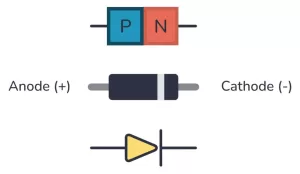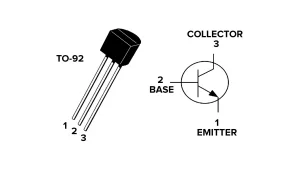
Difference between Diode and Transistor: Exploring Types, Functions, and Their Future
October 11 2023 
Inquiry
Global electronic component supplier AMPHEO PTY LTD: Rich inventory for one-stop shopping. Inquire easily, and receive fast, customized solutions and quotes.
QUICK RFQ
ADD TO RFQ LIST
Diodes and transistors are two of the most essential electronic components in the realm of electronics, and they have numerous uses in contemporary gadgets. Although both parts are constructed of semiconductor materials, their structures and functions are distinct. Diodes are two-terminal electronic components that let one direction of current flow while blocking the opposite. On the other hand, transistors are three-terminal devices that may switch or amplify electronic signals. In this blog, we will explore the differences between diodes and transistors in detail, covering their types, functions, applications, and so on.
Diode Anode and Cathode

Types of Diodes
There are many different types of diodes, each with its own unique characteristics and applications. Here are a few examples:- Double diode: Two diodes are connected in series to form a double diode. It is frequently utilized in situations that call for high-voltage rectification.
- Diode laser: A coherent light-emitting laser of this kind. It is extensively employed in fields like laser surgery and optical communication.
- Diode Dynamics SS3: This high-performance LED headlight bulb is made by Diode Dynamics. It is renowned for both its extended lifespan and bright output.
- Diode rectifier: A diode rectifier is a type of rectifier circuit that transforms alternating current (AC) to direct current (DC) using diodes.
- Flyback diode: To avoid reverse voltage spikes, a flyback diode is linked across an inductive load. In switching power supplies, it is frequently utilized.
Types of Transistors

- Bipolar junction transistors (BJTs): BJTs are the earliest and most common form of transistor. NPN and PNP are the two variants that are offered.
- Field-effect transistors (FETs): More recent than BJTs, FETs have some advantages over them, including faster switching rates and less power consumption. Metal-oxide-semiconductor field-effect transistors (MOSFETs) and insulated-gate bipolar transistors (IGBTs) are the two primary types of FETs.
How does the Diode work?
The PN junction, which separates two semiconductor materials with varying amounts of doping, is the mechanism by which diodes function. The positive charge carriers (holes) in the P-type material are in excess, whereas the negative charge carriers (electrons) are in excess in the N-type material. The holes in the P-type material and the electrons in the N-type material are drawn to the opposing terminals when a forward voltage is applied to a diode, resulting in a current flow. A reverse voltage, on the other hand, repels the electrons and holes from the opposing terminals and stops current flow.How do transistors work?
There are two main types of transistors: bipolar junction transistors (BJTs) and field-effect transistors (FETs). BJTs work by controlling the flow of majority charge carriers (electrons or holes), while FETs work by controlling the flow of minority charge carriers.How to test Diode?
A diode can be tested in a number of different ways to verify if it is functioning properly. Using a multimeter is one such approach. Set the multimeter to the diode mode and attach the positive lead to the anode and the negative lead to the cathode of the diode to test a diode. A voltage drop of approximately 0.7 volts should be visible on the multimeter if the diode is functioning properly. Using a light-emitting diode (LED) is another method of testing a diode. Connect the cathode of the diode to the negative terminal of the LED and the anode to the positive terminal of the LED to test the diode. The LED ought should light up if the diode is functioning properly.How to test a Transistor with a multimeter?
- Dial in the multimeter's diode setting.
- Connect the positive lead of the multimeter to the transistor's base and the negative lead to the transistor's emitter.
- The multimeter value should be close to 0.7 volts.
- Connect the positive lead of the multimeter to the emitter and the negative lead to the base, reversing the direction of the leads. The multimeter should display an infinite resistance reading.
- Replicate steps 2-4 while attaching the multimeter's positive lead to the transistor's collector and its negative lead to its base and emitter. When the positive lead is linked to the base and the emitter, the multimeter should register approximately 0.7 volts and infinite resistance, respectively.
- The transistor is in good operating order if it passes each of these tests.
Transistor Sizing and Advancements
Thanks to advancements in the technology of semiconductor production, transistors have shrunk throughout time. More sophisticated and potent electrical gadgets, like contemporary CPUs and cellphones, have been made possible as a result.Key Differences Between Diodes and Transistors
Diodes and transistors are essential components in modern electronics. They are used in a wide range of devices, from smartphones and computers to cars and airplanes. The following table summarizes the key differences between diodes and transistors:| Characteristic | Diode | Transistor |
| Number of terminals | 2 | 3 |
| Current flow | Unidirectional (one direction only) | Bidirectional (two directions) |
| Function | Rectifier, switch | Amplifier, switch |
| Applications | Power supplies, radios, TVs | Computers, smartphones, and other digital devices |
Video related to the Difference between Diode and Transistor
What is a Diode used for?
- Rectification: In order to convert alternating current (AC) into direct current (DC), diodes are frequently utilized. By allowing current to flow during the positive half-cycle and blocking it during the negative half-cycle, they transform the AC waveform into a pulsing DC waveform.
- Power Supply: Diodes are essential components in power supply circuits. They are employed in rectifier circuits to transform AC mains electricity into DC power that electronic devices can utilize.
- Voltage Regulation: Zener diodes, a particular kind of diode, are utilized as voltage regulators. Even when the input voltage varies, they keep a constant voltage across their terminals. This guarantees a steady power supply for delicate electronic parts.
- Signal Demodulation: To recover the original modulating signal from a modified carrier wave, demodulation circuits use diodes. This method is frequently applied in radio and television broadcasts.
- Signal Clipping and Clamping: Electrical signals' amplitudes can be clipped or clamped using diodes. By eliminating the portions of a signal that surpass a predetermined threshold, clipping diodes reduce the voltage level of a signal. The entire waveform is moved up or down by clamping diodes, which guarantee that it stays within a certain voltage range.
- Logic Gates: Diodes play a crucial role in the creation of logic gates, the fundamental units that make up digital circuits. They are utilized to produce logical operations like AND, OR, and NOT as well as control the flow of current.
- Protection: Diodes are used as protective mechanisms to guard delicate electronic components against voltage transients and spikes. For instance, TVS (Transient Voltage Suppression) diodes are made to absorb and dissipate highly energetic transient occurrences, safeguarding circuits from harm.
- Light-Emitting Diodes (LEDs): LEDs are a particular kind of diode that emits light when electricity passes through them. They are extensively utilized in optoelectronic communication systems, displays, indicators, and lighting applications.
What does a Transistor do?
- Amplification: Signal amplification is the main application of transistors. They can make weak electrical signals stronger or louder so that they can be processed or sent over great distances without suffering great loss or degradation.
- Switching: Transistors can function as electronic switches to regulate the current flow in a circuit. A transistor can switch on or off a greater current by receiving a small input signal, making it possible to switch between electronic components and circuits.
- Voltage Regulation: Voltage regulator circuits use transistors to keep the output voltage constant despite changes in the input voltage or the load. In power supply and electrical systems, they aid in regulating and controlling the voltage levels.
- Oscillation: Transistors play a significant role in the design of oscillators, which produce continuous waveforms at particular frequencies. Oscillators generate steady, accurate signals that are useful in many applications, such as radio transmission and timing circuits, by using the characteristics of transistors.
- Current Amplification: Transistors have the ability to amplify current signals, which enables them to drive loads that need higher current levels than the input signal can supply. In power amplification circuits and audio amplifiers, this property is especially helpful.
- Logic Gates: Transistors play a crucial role in the creation of logic gates, the fundamental building blocks of digital circuits. Complex digital computations are made possible by logic gates, which combine numerous transistors to carry out logical operations like AND, OR, and NOT.
- Memory Storage: Transistors are utilized in memory devices like flash memory and dynamic random-access memory (DRAM). They do this by managing the movement of electrical charges within the transistor structure, which is how they store and retrieve digital information.
- Radio Frequency (RF) Amplification: Transistors are frequently employed in RF amplifiers, which are devices that strengthen weak radio frequency signals. They make it possible for equipment like radios, televisions, and wireless communication systems to receive and transmit radio waves.
The Future of Diodes and Transistors
As technology develops, fascinating possibilities lie in the future of diodes and transistors. The following developments and trends may affect how these electrical components are used in the future:- Miniaturization: Over the years, diodes and transistors have already experienced tremendous miniaturization, resulting in the creation of more compact and potent electronic gadgets. With the potential for even smaller and more effective diodes and transistors, this trend is likely to continue, enabling the development of ever more compact and portable electronics.
- Integration: Diodes and transistors are increasingly being integrated into single chips or systems-on-chips (SoCs). Through this integration, electronic gadgets can operate better, use less energy, and have more functionality. Future developments might involve packing more features and components onto a single chip, creating ever more robust and adaptable gadgets.
- Higher Frequencies: As the need for quicker and more effective communication systems grows, higher frequency-capable diodes and transistors will be crucial. The development of transistors and diodes that can operate at higher frequencies may be made possible by improvements in production methods and materials. This would increase the speed at which data can be sent and the efficiency of signal processing.
Conclusion
In conclusion, diodes and transistors are essential parts of electronics, each with special properties and uses. Transistors amplify and switch electronic signals, whereas diodes primarily control the flow of electricity. We obtain insights into the roles and operating principles of diodes and transistors by comprehending how they differ from one another, which makes it possible for us to construct and debug electrical circuits successfully. This knowledge will surely improve your grasp of the intriguing world of electronics, whether you're a novice or an expert aficionado. Diode Anode and CathodeTypes of DiodesTypes of TransistorsHow does the Diode workHow do transistors workHow to test DiodeHow to test a Transistor with a multimeterTransistor Sizing and AdvancementsKey Differences Between Diodes and TransistorsVideo related to Difference between Diode and TransistorWhat is a Diode used forWhat does a Transistor doThe Future of Diodes and TransistorsConclusion
Related Articles
- ·Stratix 10 VS Stratix V: Which FPGA is Right for Your Next Project?
- ·Intel Xeon Platinum 8454H vs AMD EPYC: Which Reigns Supreme?
- ·A Deep Dive into the AMD EPYC 4564P Processor
- ·MSP430F5438A vs MSP430F5529: A Detailed Analysis of Their Capabilities
- ·Comparing MSP430F6659 and MSP430F5419A: Which One is Right for Your Project?
- ·Exploring the Features of MSP430F5529 and MSP430F5638 Microcontrollers
- ·Demystifying 20 Microcontroller Projects for Beginners
- ·Unveiling the Ultimate Guide to Microcontroller Programming
- ·4680 Battery: Unveiling the Power Potential of the Next-Gen Cell
- ·Exploring the Case Studies on Arduino Applications
Populer Posts
